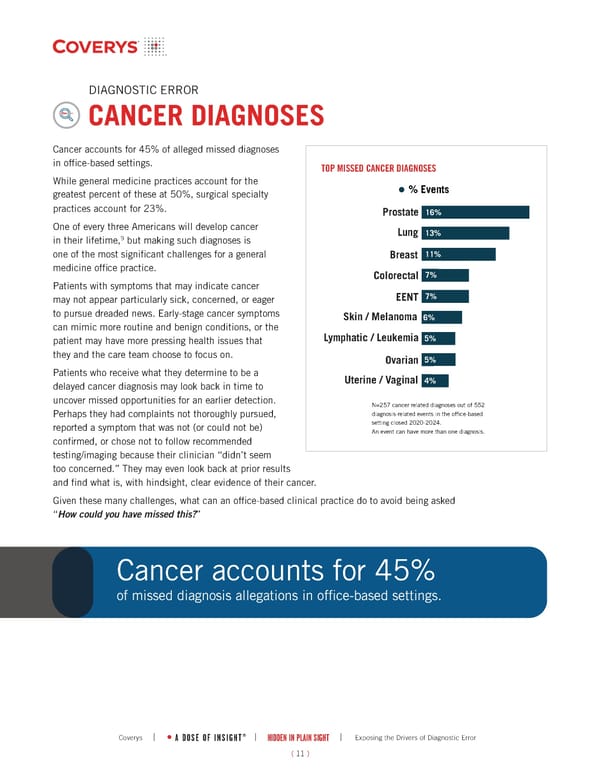DIAGNOSTIC ERROR CANCER DIAGNOSES ( 11 ) Cancer accounts for 45% of alleged missed diagnoses in office-based settings. While general medicine practices account for the greatest percent of these at 50%, surgical specialty practices account for 23%. One of every three Americans will develop cancer in their lifetime,9 but making such diagnoses is one of the most significant challenges for a general medicine office practice. Patients with symptoms that may indicate cancer may not appear particularly sick, concerned, or eager to pursue dreaded news. Early-stage cancer symptoms can mimic more routine and benign conditions, or the patient may have more pressing health issues that they and the care team choose to focus on. Patients who receive what they determine to be a delayed cancer diagnosis may look back in time to uncover missed opportunities for an earlier detection. Perhaps they had complaints not thoroughly pursued, reported a symptom that was not (or could not be) confirmed, or chose not to follow recommended testing/imaging because their clinician “didn’t seem too concerned.” They may even look back at prior results and find what is, with hindsight, clear evidence of their cancer. Given these many challenges, what can an office-based clinical practice do to avoid being asked “How could you have missed this?” | HIDDEN IN PLAIN SIGHT | Exposing the Drivers of Diagnostic Error A DOSE OF INSIGHT ® Coverys | % Events Prostate Lung Breast Colorectal EENT Skin / Melanoma Lymphatic / Leukemia Ovarian Uterine / Vaginal 16% 13% 11% 7% 7% 6% 5% 5% 4% TOP MISSED CANCER DIAGNOSES Cancer accounts for 45% of missed diagnosis allegations in office-based settings. N=257 cancer related diagnoses out of 552 diagnosis-related events in the office-based setting closed 2020-2024. An event can have more than one diagnosis. Prostate Lung Breast Colorectal EENT Skin / Melanoma Lymphatic / Leukemia Ovarian Uterine / Vaginal VISUAL #10 - TOP MISSED CANCER DIAGNOSES 16% 13% 11% 7% 7% 6% 5% 5% 4%
 Hidden in Plain Sight: Exposing the Drivers of Diagnostic Error - PART II Page 11 Page 13
Hidden in Plain Sight: Exposing the Drivers of Diagnostic Error - PART II Page 11 Page 13